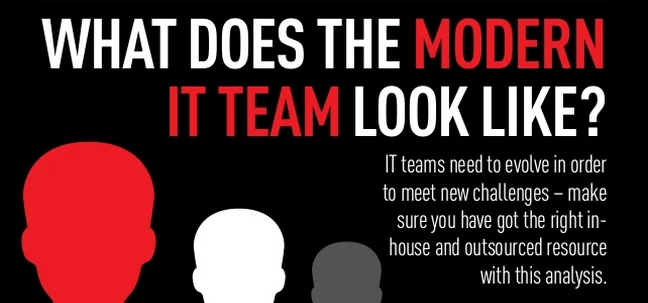
Partner Article
What does the modern IT team look like?
IT teams need to evolve in order to meet new challenges – make sure you have got the right in-house and outsourced resource with this analysis.
IT teams are evolving. The old model of a Finance/IT Director supported by Infrastructure and Application managers, with a host of network engineers and developers, is changing to meet new challenges.
In most organisations, IT used to be almost entirely about finance: sales, cash flow, payroll and purchasing. Organisations often developed their own software and built their own networks. They needed network engineers, a Wintel team, a mainframe team … Now, much of the software is off-the-shelf, running on commodity hardware, or abstracted to SaaS – the CIO has emerged to coordinate it all.
The Chief ‘I’ Officer role is complex. Officially the ‘I’ stands for Information, but it includes Infrastructure, Intelligence, Integration and Innovation. In a large organisation, some of these might be individual job descriptions, or they might be bundled into other roles.
Architecture, Business Change, Service Aggregation, SaaS, PaaS, MSP, Cloud Storage, Cloud Compute, Disaster Recovery, Governance, Compliance, Business Intelligence, Infrastructure.
Every organisation is different. The number of people you need to fulfil all the roles depends on the size of the organisation, the market sector in which it operates, and to some extent on location and legacy. Here’s a selection of the sort of people most mid-to-large organisations need in IT.
The IT architect uses IT to meet specific business requirements. IT architects focus on the cost/benefits of investments in IT. This requires skill in planning, implementing, and managing infrastructure and applications.
Business Intelligence analysts use data to improve efficiency and profits. They may work for an organisation or play a consultancy role. Data mining the organisation’s records, they can understand where the organisation stands, where they can improve and where they can reduce costs.
The Chief Compliance Officer is primarily responsible for overseeing and managing all regulatory compliance issues within an organisation. Compliance with data protection and ensuring privacy and security in IT are all so important that this particular aspect may be a separate role.
Orchestrating this changing mix of in-house professionals and outsourced services is a huge job, some of which can itself be outsourced. A carefully designed SLA with a good managed services provider (MSP) can take a lot of weight off the CIO’s shoulders.
TAKEAWAYS:
Remember:
- The IT landscape is changing constantly – your IT team needs to evolve with it, to keep up with the times
- Plan intervals to reassess your organisation’s requirements for in-house resource and outsourced services
- The job of orchestrating a changing mix of in-house professionals and outsourced services can itself be outsourced to experts.
Get the right mix in your modern IT team, combined with outsourced services: Integrating IT- Making the Old Work with the New. Find out more by copy and pasting this link into your browser: http://bit.ly/integratedeguide
This was posted in Bdaily's Members' News section by Simon Mitchell .
Enjoy the read? Get Bdaily delivered.
Sign up to receive our popular morning National email for free.








 A game-changing move for digital-first innovators
A game-changing move for digital-first innovators
 Confidence the missing ingredient for growth
Confidence the missing ingredient for growth
 Global event supercharges North East screen sector
Global event supercharges North East screen sector
 Is construction critical to Government growth plan?
Is construction critical to Government growth plan?
 Manufacturing needs context, not more software
Manufacturing needs context, not more software
 Harnessing AI and delivering social value
Harnessing AI and delivering social value
 Unlocking the North East’s collective potential
Unlocking the North East’s collective potential
 How specialist support can help your scale-up journey
How specialist support can help your scale-up journey
 The changing shape of the rental landscape
The changing shape of the rental landscape
 Developing local talent for a thriving Teesside
Developing local talent for a thriving Teesside
 Engineering a future-ready talent pipeline
Engineering a future-ready talent pipeline
 AI matters, but people matter more
AI matters, but people matter more